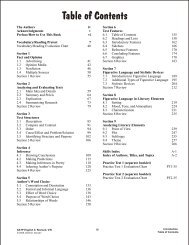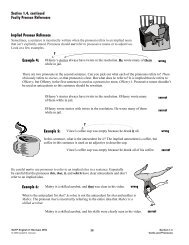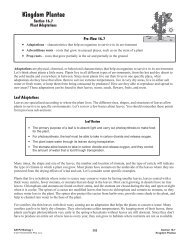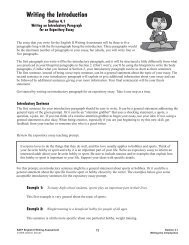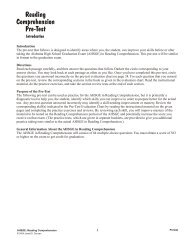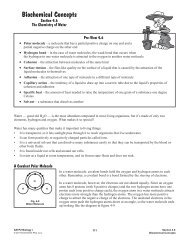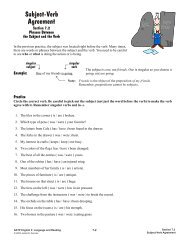Mississippi SATP2 Algebra I Student Review Guide - Enrichment Plus
Mississippi SATP2 Algebra I Student Review Guide - Enrichment Plus
Mississippi SATP2 Algebra I Student Review Guide - Enrichment Plus
Create successful ePaper yourself
Turn your PDF publications into a flip-book with our unique Google optimized e-Paper software.
Inequalities<br />
Section 8.5<br />
Understanding Averages<br />
Working with averages is another real-world situation that may require the use of<br />
inequalities. When it comes to averages, the one that students are most aware of is the<br />
grades they get for school work. Sounds like a good place to begin.<br />
Average<br />
sum of item<br />
number of items<br />
You can figure out your grade point average by adding all your test scores and then<br />
dividing by the total number of tests. You use this same process to find any average. An<br />
average is the sum of items divided by the number of items.<br />
Let’s start with finding a current average. Suppose you have taken five<br />
tests this semester. Your scores are 88, 75, 91, 77, and 80.<br />
{ 88 , 75, 91, 77, 80 }<br />
Calculate your current average by totaling the current grades and dividing<br />
by five. Round to the nearest whole number. With these grades, your<br />
average is 82.<br />
88 + 75 + 91 + 77 + 80<br />
5<br />
= 82<br />
Example 1:<br />
You have an A average. Your grades are 90, 95, 92, 97, and 93. There is a test scheduled on Friday<br />
before spring break. If you miss the test, you cannot make it up. How much damage can one zero<br />
do to your average if your family decides to leave early for spring break?<br />
Step 1: Calculate the current average.<br />
Step 2: Add one zero and recalculate the average.<br />
Step 3: How much difference did the zero make? Original<br />
average minus the new average is fifteen.<br />
90 + 95 + 92 + 97 + 93<br />
5<br />
90 + 95 + 92 + 97 + 93 + 0<br />
6<br />
93 – 78 = 15<br />
= 93<br />
= 78<br />
One zero made a 15 point difference. You have gone from an A to a C! If<br />
there had been fewer grades, the difference would have been even more drastic.<br />
Now let’s say you have a test coming up and you want to know what grade you need to maintain your average. Since<br />
you probably don’t mind if your average goes up, your calculation becomes an inequality. You want to know the<br />
minimum grade, but any grade higher than that will also work!<br />
Example 2:<br />
Your first five test grades are 88, 75, 91, 77, and 80. What grade do you need to make on the sixth<br />
test to maintain your average?<br />
Step 1:<br />
First, calculate your current average by totaling the<br />
current grades, and then divide by five. From<br />
above, you’ve already seen that these grades<br />
average to 82.<br />
88 + 75 + 91 + 77 + 80<br />
5<br />
= 82<br />
Step 2: To calculate your average after test six, you would<br />
add a variable, T, to stand for the test you haven’t<br />
taken yet and divide by six.<br />
88 + 75 + 91 + 77 + 80 + T<br />
6<br />
<strong>SATP2</strong> <strong>Algebra</strong> 149<br />
© 2010 <strong>Enrichment</strong> <strong>Plus</strong>, LLC<br />
Section 8.5<br />
Inequalities



